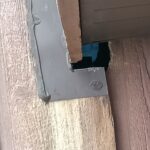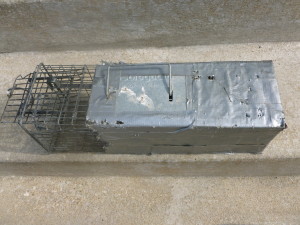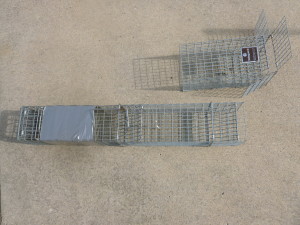Squirrel Trapping 101
Have you ever wondered what successful squirrel trapping and removal looks like?
This post is meant to simply explain and show steps one may follow if squirrels are calling your home theirs. After a description, there are a couple of very recent videos which show the process.
Step 1 : Identify where the squirrels are getting in
 Identifying where the squirrels are getting into the building is the all important first step. This is because the entry/exit spot or spots is where the traps will be going.
Identifying where the squirrels are getting into the building is the all important first step. This is because the entry/exit spot or spots is where the traps will be going.
Additionally, if more than one entry/exit, these areas need attention during the trapping process and afterwards-when you enter the repair phase. (See the second video!!!)
This probably will require a ladder and possibly getting on the roof: be careful.
Step 2: Acquire Two Styles of Squirrel Trap
 The first kind is a small, cage-style live trap. This type of trap has door at one end which closes when a squirrel goes inside to get bait.
The first kind is a small, cage-style live trap. This type of trap has door at one end which closes when a squirrel goes inside to get bait.
This style of trap will capture any squirrels that are OUTSIDE of the home when the traps are set and are in the vicinity of the exit/entrance.
An example of this type of trap is to the right and we have modified it a little by wrapping duct tape around it.
 The second kind of trap is a one-way door trap.
The second kind of trap is a one-way door trap.
Set in place by an exit, the wire door pivots to let squirrels go out when they push on it but not back in.
This style of trap is intended to catch squirrels that are INSIDE the home when the traps are set.
The top trap in the picture to the right is a one-way door. The bottom trap is long and has one way doors in it. Attaching the two together gives a lot of room to accommodate a lot of squirrels leaving.
Step 3 : Set the traps
Setting the cage style traps with bait is fairly easy. A nut-based bait is added to the trap and the traps are placed on the roof or house by the entry taking into account routes of travel..
The one way door traps are place at the holes. They are attached in a way that the squirrels are blocked/funneled into the traps. Often screening is used to make sure any ways around the trap are blocked. Since the trap works when the squirrels exit, they can’t have options when exiting. The blocking assures this.
It just takes some creativity to get the one-way door trap in place and effectively working. But once in place, this type of trap is super efficient when it works as intended and all the squirrels are inside when the trap is put in place. Fear not, there are examples in the videos below.
Successful Squirrel Trapping
Here is an example of identifying a hole and setting up traps.

The second example shows the same styles of traps in use. It also makes the point of knowing where all the squirrels’ holes are.

Akron, Canton, Kent Squirrel Removal
We hope this post has been a helpful overview of squirrel trapping basics.
Getting these pesky critters of of homes restores the home’s integrity and stops the annoying noises of squirrels in the attic, walls, soffits and ceiling.
If you want to tackle a job like this, try out those two types of traps. You’ll have good success if you place them by the squirrels’ entrances.
For any help in the Akron, Canton, Kent Ohio area, please give us a call.

